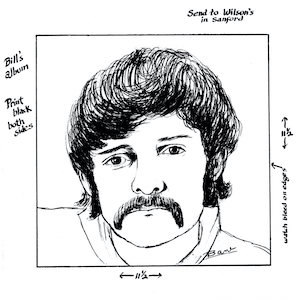
Bill Stone – Stone
Drag City – 12 February 2021
In the world of record collecting the rare private pressing from the late sixties and early seventies can be a hotly desired thing of wonder and delight. Limited in availability because mostly they were funded by the artist, pressed in small runs of 500 or at best 1000 copies and lacked anything resembling meaningful distribution. The artist would have sold them at whatever gigs they were playing, and that would have been about it. However, thanks to a happy convergence of factors such as the styles and progressions of that particular era in music (I am particularly thinking of the popularity of singer songwriters and the explosions in psychedelia and prog that all evolved around this time), adventurous and artistically mature music was being made as much on the fringes as it was in the mainstream. Add to that the elusively magical sound of the times, something I often refer to as that ‘analogue sound’, where the music just somehow sounds so much more resonant and deeper. If you are unsure what I mean then maybe just contrast the audio on a late 60s / 70s record to that heard about 15 years later when a much cleaner, digitised sound was coming in. The latter has aged badly in many cases, but those fifty-year-old records just seem to have been uncorked from a period of fine vintage and many singer-songwriters still try and capture the essence of those times even now.
Nowadays an album such as this 1969 debut by Bill Stone is categorised as Outside Folk, it is funny how so many artists in those decades were blissfully making music in a genre that they did not even know existed. This is true too of many a Freakbeat disc, many an Acid Folk nugget, even a Northern Soul floor filler, these terms were simply not in circulation at the time. In actual fact, all Bill Stone was doing was expressing himself in the medium of the day and capturing the fruits of his creation on the best equipment that he could afford to. That just happened to be a 2-track Panasonic tape recorder utilised in the ambience of a pottery studio. However, what may sound on paper like severe limitations did not deter Bill from following his kaleidoscopic vision. There is a track on here called ‘Charlottes Town’ that features a sound not unlike that of a theremin being shoved down a blender. Sounds bend and shape in the most impossible to nail down manner.
Essentially Bill Stone was a folk artist with a self-confessed interest in Dylan and Donovan. Other than the fact that his starting point is that of an acoustic troubadour, I cannot really say that these influences jump out at you when listening to ‘Stone’. A far more tangible reference point would be the third album by The Velvet Underground. There is something in the closety simplicity of the song structures, the dreamy thrust of the acoustic chord patterns and the low hum of the electric guitar pathways that flow across the images which lend this record a similar tension. Bill Stone had been playing his music around the folk clubs of rural Maine half a century ago, a modest performer who never appeared to nurture any serious ambitions for fame or recognition. This was his only LP and it featured both himself and Tom Blackwell on guitars, Arthur Webster on bass, Bob Blackwell and Skip Smith on drums and lastly a little Beth Waterhouse on vocals. The cover art may look deliciously homemade but it was actually the work of Doug Bane, who went on to wider acclaim in the art world for his ‘cosmic’ Native American images. Inevitably, the record remained in obscurity and Bill Stone’s music career slowly settled into the barroom covers scene as he entered married life. He went on to a teaching and publishing career, he even became a cab driver at one stage. It is the latter occupation that has finally inspired him to write and play music again.
For the time being, you can explore the restored obscurity of his 1969 debut album ‘Stone’. For many years the pitfall of a high valued, widely unknown, private pressing collectors’ piece was that their status sometimes surpasses the quality of the music. For some just being hard to find was desirability enough, it mattered little if the actual music did not quite hit the mark because you would probably never hear it anyway. Fortunately, the availability of so much music to try before you buy has eliminated this hazard somewhat. That said, this Bill Stone record has no such worries; it ticks all the period boxes for sure, the sound and style are all the classic 60s/70s retro genuine article. But the songs are pretty intriguing too and well worth a listen. Bill Stone wrote songs that played out like dreamy meditations. His concerns were mainly personal as his lyrics ponder relationships and human interactions. The delivery is soft-focused and hushed, with echoes and distant thunder rattling the backdrop. Lo-fi before lo-fi existed and yet melancholic during a time when such a thing was in the mainstream. There’s a nice even flow too, I get the impression these sessions were not over thought, more like they just pressed record and let the magic happen naturally. This is definitely one of those rare records that deserve the wider discovery it will now surely enjoy.
Bill Stone Online:
Drag City-https://www.dragcity.com/artists/bill-stone
Pre Order-https://www.dragcity.com/products/stone

